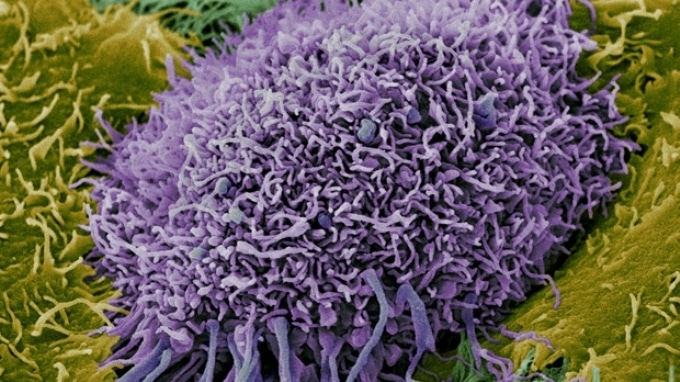Nov 8 2016
 Credit: Cancer Research UK
Credit: Cancer Research UK
A new laboratory research* presented at the 2016 National Cancer Research Institute (NCRI) Cancer conference talks about how tagging gold nanoparticles with a minute dose of radiation has been helpful in tracing the precious metal as it delivers a drug directly into the core of cancer cells.
A team of researchers from the CRUK/MRC Oxford Institute for Radiation Oncology have been involved in finding better approaches to deliver a drug directly into the control room of cancer cells, in which the chromosomes are stored. This specific drug targets telomerase, a molecule that is important to the development of the protective caps located at the end of chromosomes known as telomeres.
In a majority of cells in the body, telomeres serve as an integrated timer to ensure that the cell does not live beyond its expiry date. Each time the cell divides, telomeres reduce. Once a significant length is reached, the cell cannot divide anymore and it dies. Cancer cells are able to evade this safety check by reactivating telomerase allowing them to carry on growing out of control.
Gold is precious in more than one way. We have used tiny gold nanoparticles loaded with targeted drugs to kill cancer cells in the laboratory. Our long term goal is to design new treatments for cancer patients based on this promising approach.
Professor Kate Vallis, lead researcher based at the CRUK/MRC Oxford Institute for Radiation Oncology
Delivering effective drugs into cancer cells is one of the biggest challenges in treating cancer; especially to the area the chromosomes are located. Gold nanoparticles have been established as being well suited for absorption into cells, safely transporting drugs that could otherwise be hindered.
By designing the gold nanoparticles and incorporating the radioactive tracer, the research team could prove that their drug was making contact with the target in skin cancer cells grown in the lab and was stopping telomerase growth, thus halting the progress of cancer.
Gold has been used in medicine for many years and this research adds further insight into its potential. Ensuring that treatment is accurately targeted at cancer and avoids healthy cells is the goal for much of cancer research, and this is an exciting step towards that.
Sir Harpal Kumar, Cancer Research UK’s chief executive
In this research, the radioactive tracer was used to precisely trace the drug. The same technique can also be applied to transport a dose of radioactivity to cancer cells, helping to destroy them. This second dose is particularly powerful as the inactivation of telomerase causes cancer cells to become more sensitive to radiation.
Research continues to shed light on how cancer cells behave and how to effectively deliver a lethal payload to the tumour. This exciting research offers that potential and needs further investigation to see how it would be used in patients. The future looks exciting with research such as this improving the way the disease is treated.
Dr Karen Kennedy, Director of the NCRI
References
* Gold nanoparticle radiopharmaceuticals for the selective treatment of telomerase-positive tumours
http://abstracts.ncri.org.uk/abstract/gold-nanoparticle-radiopharmaceuticals-for-the-selective-treatment-of-telomerase-positive-tumours/